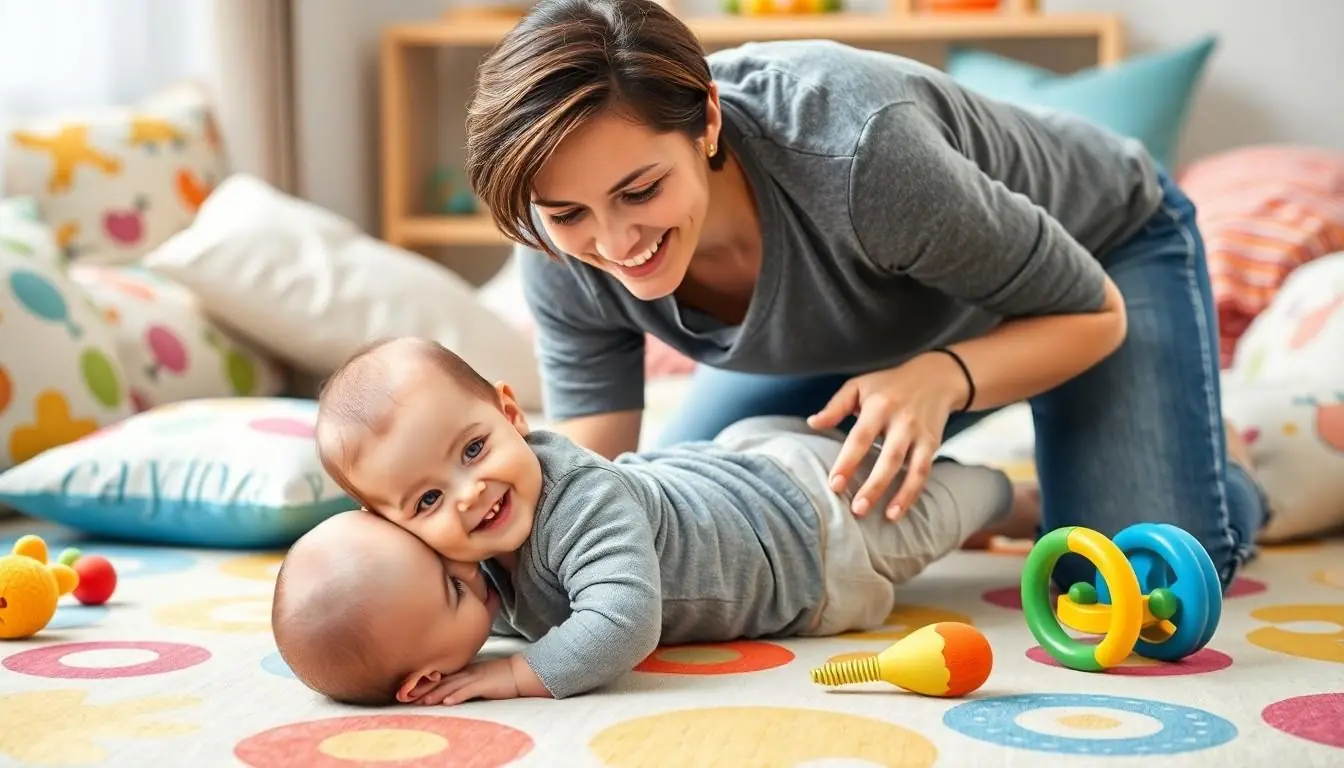In the world of parenting, few experiences are as heart-pounding as the moment a baby decides to flip over for the first time. It’s like watching a tiny gymnast master a daring move, complete with a triumphant grin that says, “Look, Mom! No hands!” But flipping babies isn’t just about the cuteness factor; it’s a rite of passage that sparks joy and a touch of panic in parents everywhere.
Table of Contents
ToggleOverview of Flipping Babies
Flipping over for the first time marks a crucial developmental milestone for infants. This skill often surfaces between 4 to 6 months of age. Parents typically celebrate this achievement, capturing the moment on video. Upon flipping, babies enhance their physical strength and coordination.
Strengthening muscles during flipping supports other motor skills, such as sitting and crawling. Parents can encourage this skill by providing ample tummy time. Tummy time allows babies to practice lifting their heads and eventually rolling over.
Observing a baby master this skill evokes a sense of joy and accomplishment. New parents may also experience a subtle mix of concern as mobility increases. An active baby explores new surroundings and encounters potential hazards.
Flipping introduces new perspectives for babies. A flipped position opens up opportunities for visual exploration and cognitive development. Often, babies become more curious and engaged when they can see their environment from different angles.
As infants grow, the frequency of flipping may vary. Some may flip enthusiastically, while others take their time to master the skill. Every baby develops at their own pace, highlighting the importance of patience and support from parents.
Techniques for Flipping Babies

Flipping baby techniques enhance motor skills and coordination. Parents can use a variety of methods to encourage this developmental milestone.
Manual Techniques
Manual techniques involve gentle guidance from parents. Using hands, they can assist babies during tummy time. Specifically, rolling the baby towards themselves makes the process smoother. Encouraging the baby to push off with their arms promotes strength. Parents can also create a playful environment that includes toys just out of reach. This motivation incentivizes movement and flipping. Gradually, parents will notice improvements in the baby’s confidence and ability.
Assistive Devices
Assistive devices offer additional support during flipping. For instance, rolling mats help create a safe area for practice. Bouncers and play gyms stimulate babies both physically and visually. They’re designed to encourage reaching and rolling in a fun way. Moreover, soft pillows provide cushioning as babies explore their movement. Choosing the right device is crucial, as each baby responds differently. Tracking progress with these tools allows parents to better support their baby’s development.
Benefits of Flipping Babies
Flipping contributes significantly to infant development. This milestone offers various benefits that positively affect both physical health and psychological well-being.
Physical Health
Flipping enhances muscle strength. Babies build core, arm, and leg muscles during this activity. Increased muscle tone supports essential motor skills like sitting and crawling. Joint flexibility improves, reducing the risk of injury as they grow. Babies who flip exhibit better coordination, which aids in overall physical development. Activities like tummy time encourage muscle engagement. Therefore, parents promoting flipping contribute actively to their child’s growth milestones.
Psychological Impact
Flipping fosters confidence in babies. Mastering this skill provides a sense of achievement, leading to increased self-esteem. Engaging in flipping enhances cognitive development as babies explore their surroundings from new angles. Curiosity grows as they interact more with their environment. Additionally, these experiences promote joy and excitement, enriching their emotional health. Caregivers who celebrate these achievements play a crucial role in reinforcing positive emotional connections. Overall, flipping benefits both mind and body, making it a pivotal developmental milestone.
Safety Considerations
Physical safety remains a top priority when a baby starts flipping. Infants can easily roll off surfaces like beds or changing tables, leading to potential injuries. Parents must ensure that the area around the baby is soft and free from sharp objects. Creating a safe environment helps prevent accidents during practice.
Supervision proves essential while babies explore their flipping skills. Close monitoring allows caregivers to intervene promptly if the baby rolls into a dangerous space or position. Keeping a watchful eye ensures that the baby receives immediate support and encouragement.
Using appropriate gear contributes to safety during flipping activities. Soft mats designed for infants cushion falls and provide traction, reducing the risk of injury. Choosing well-made play gyms or rolling mats adds an extra layer of protection, ensuring the baby’s safety as they practice.
Getting professional guidance can enhance safety measures as well. Pediatricians can offer personalized advice based on a baby’s development, ensuring that parents make informed decisions. Attending parenting classes may also provide valuable insights on safely encouraging physical milestones.
Recognizing the baby’s limits is crucial when encouraging flipping. Pushing too hard can lead to frustration or even injury. Allowing babies to progress at their own pace ensures that they feel comfortable and secure while mastering new skills.
Lastly, understanding when to introduce new techniques plays a key role in safety considerations. Parents should avoid overwhelming their babies with multiple methods at once. Introducing one technique at a time allows the baby to focus and adapt without stress, promoting a safer learning environment.
Flipping marks an exciting chapter in a baby’s growth journey. This milestone not only showcases their physical development but also nurtures their curiosity and confidence. As babies learn to flip, they explore their environment in new ways, fostering cognitive growth alongside motor skills.
Parents play a crucial role in this process by providing encouragement and a safe space for exploration. With the right techniques and tools, caregivers can support their little ones as they master this skill. Ultimately, flipping is more than just a cute trick; it lays the foundation for future physical and emotional milestones.


